Top 7 Basement Flood Alarms for 2025
Flooding is almost inevitable for most basements, with 95% experiencing water penetration during heavy rain or snow. The financial impact can be severe – homeowners spend an average of $15,000 on water damage repairs, and mold can grow within 24 hours of flooding. A reliable flood alarm can save you from these headaches by providing early warnings, smartphone alerts, and even automatic water shutoff.
Quick Overview of the Top 7 Basement Flood Alarms:
- Kangaroo Water + Climate Sensor ($29.99): Affordable, Wi-Fi-enabled, monitors water, temperature, and humidity.
- LeakSmart Water Leak Detection System ($200–$500+): Automatic water shutoff with fast detection and smart home integration.
- Govee Wi-Fi Water Sensors ($43.99): Budget-friendly with loud alarms, app alerts, and real-time monitoring.
- Moen Flo Smart Water Monitor ($458): Whole-home protection with automatic shutoff and advanced water flow analysis.
- YoLink Smart Water Sensor Kit ($59.99+): Long-range connectivity and expandable coverage using LoRa technology.
- Eve Water Guard ($84.95): Designed for Apple HomeKit users with a 6.5-foot sensing cable and loud alarms.
- Fibaro Flood Sensor ($80–$120): Compact, multi-functional, and compatible with Z-Wave and Apple HomeKit.
Quick Comparison:
| Product | Price Range | Alert Methods | Smart Home Compatibility | Key Features | Battery Life |
|---|---|---|---|---|---|
| Kangaroo Water + Climate Sensor | $29.99 | App notifications, email | Limited | Monitors water, humidity, temp. | 1–2 years |
| LeakSmart Detection System | $200–$500+ | App alerts, auto shutoff | Alexa, Google, Nest | Automatic water shutoff | 2–3 years |
| Govee Wi-Fi Water Sensors | $43.99 | Loud alarm, app notifications | Alexa | Wi-Fi, real-time monitoring | 1–2 years |
| Moen Flo Smart Water Monitor | $458 | App, email, text | Ring, Alarm.com | Whole-home coverage | N/A |
| YoLink Smart Sensor Kit | $59.99+ | App, SMS, email | Alexa, IFTTT | Long-range, expandable system | 2+ years |
| Eve Water Guard | $84.95 | Loud alarm, HomeKit notifications | Apple HomeKit | Extendable sensing cable | N/A |
| Fibaro Flood Sensor | $80–$120 | Sound alarm, Z-Wave notifications | Z-Wave, HomeKit | Multi-sensor, floating design | 2 years |
These flood alarms offer varying features, from budget-friendly options to advanced systems with automatic shutoff. Choose one based on your needs, budget, and smart home setup to protect your basement and avoid expensive repairs.
EVERY home should have FLOOD sensors, here are the best ones.
1. Kangaroo Water + Climate Sensor
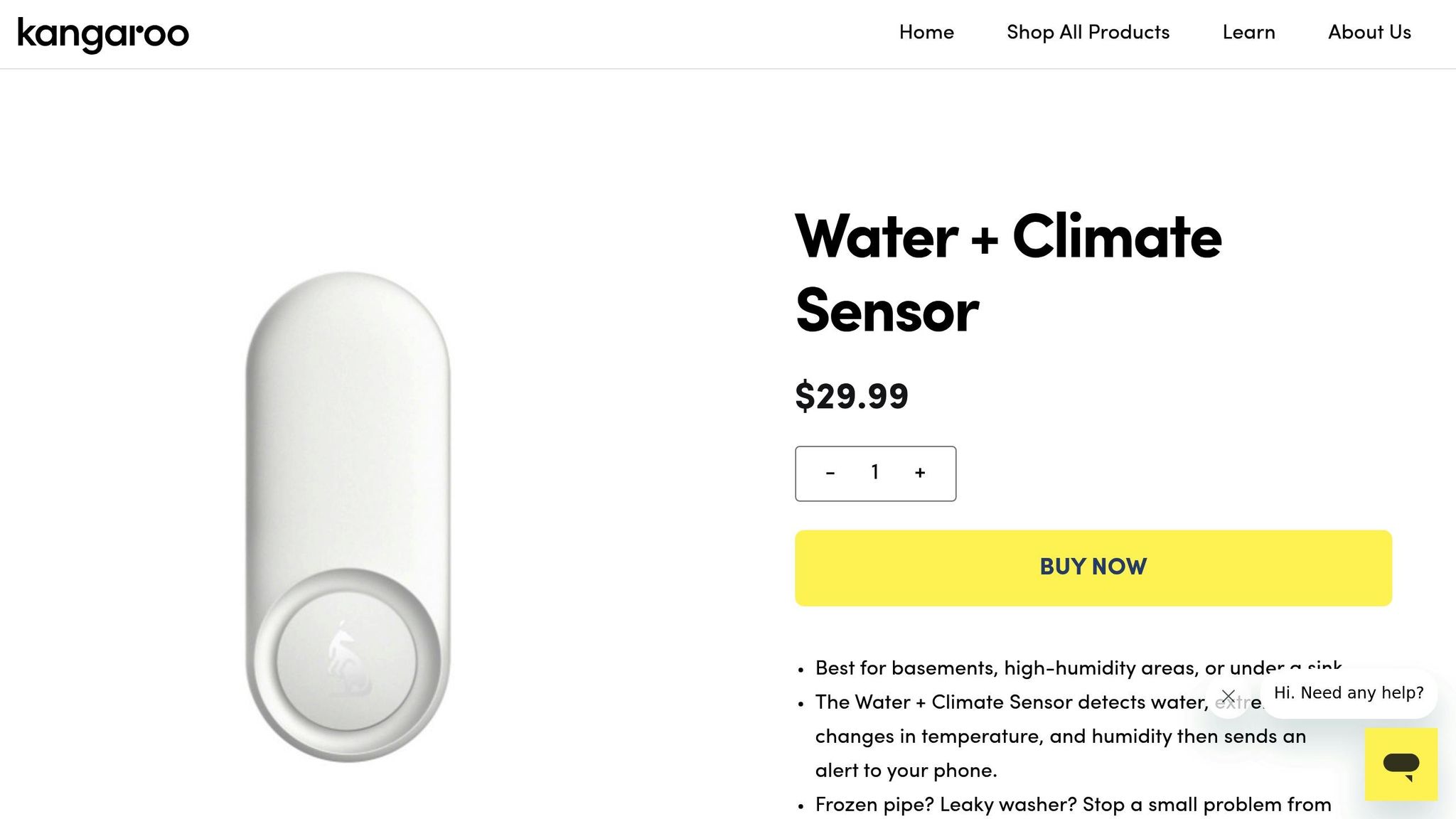
The Kangaroo Water + Climate Sensor is a versatile device designed to tackle multiple basement challenges. Priced at just $29.99, this compact sensor monitors temperature, humidity, and water leaks all at once, making it a practical choice for basement environments.
What sets this sensor apart is its straightforward, hub-free design. It connects directly to your home Wi-Fi and even supports voice control, which simplifies setup and keeps costs down. Built to endure harsh conditions, it operates reliably in temperatures ranging from 23°F (-5°C) to 122°F (50°C).
Through the Kangaroo mobile app (available for both Android and iOS), you can customize humidity and temperature thresholds to suit your basement’s specific needs. The sensor integrates seamlessly with smart home systems, adding convenience to its functionality.
When water is detected, the sensor sends immediate push notifications to your smartphone. For those subscribed to Kangaroo’s Complete Plan, additional text and voice alerts offer an extra layer of protection.
Users have praised its dependability. A Walmart customer, DickyD3, shared in May 2023 that the sensor “prevented significant water damage repeatedly”. Another satisfied buyer, Shalia, wrote in July 2021:
“This is a must-have! I keep one in my basement and bought a second for a rental property. It provides extra protection and peace of mind.”
The sensor is powered by two included AA batteries, which last up to a year, requiring minimal upkeep. It’s ideal for placement near water heaters, sump pumps, or other areas prone to condensation.
While PCMag gave it a 3.0/5 rating, highlighting its affordability and responsiveness, they noted the absence of audible alerts and limited smart home integrations. On the plus side, Kangaroo offers a damage reimbursement program under its Protect Plan, which covers water damage originating within monitored areas – offering financial peace of mind.
Next, let’s dive into another cutting-edge system designed for advanced leak detection.
2. LeakSmart Water Leak Detection System
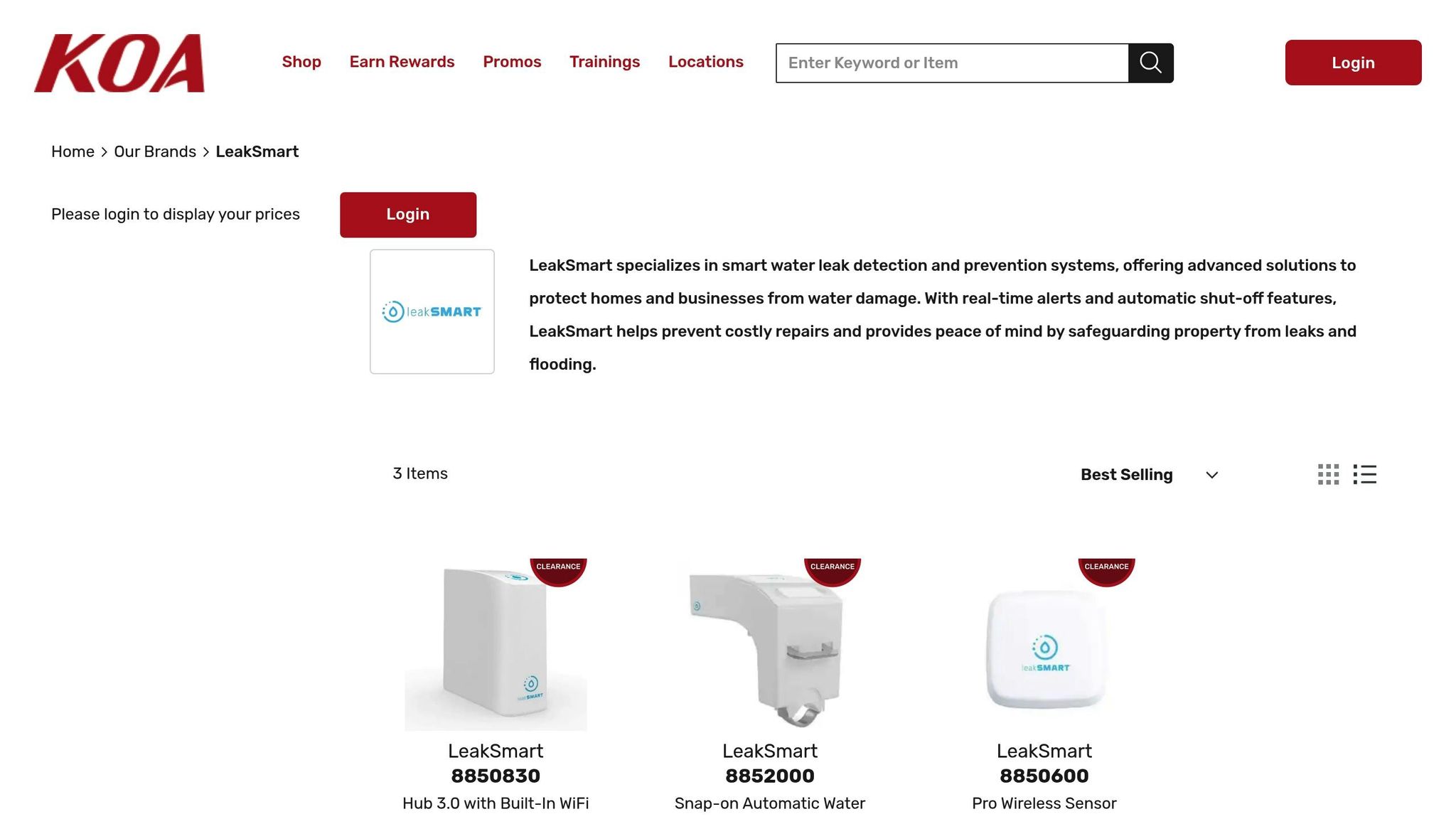
The LeakSmart Water Leak Detection System takes basement flood protection to the next level by automatically shutting off your main water supply as soon as a leak is detected.
This system includes everything you need for quick action: wireless sensors, a smart hub, a motorized water valve, and a mobile app. When the sensors detect water, they alert the hub, which notifies you and shuts off the water supply – all in under 10 seconds. That kind of speed can be the difference between a quick cleanup and costly water damage.
The sensors do more than just detect leaks – they also monitor temperature to help prevent frozen pipes. With support for up to 32 sensors, you can cover every vulnerable area in your home, from your basement to your utility room.
LeakSmart works with popular smart home systems like Google Assistant, Google Nest, Amazon Alexa, Control4, Wink, and SmartThings. This makes it easy to integrate into your existing smart home setup for seamless flood protection.
Alerts come in multiple forms, including audible alarms, light signals, app notifications, emails, SMS messages, and even freeze warnings . With so many ways to stay informed, you’ll never miss a critical update.
Setting up the system is straightforward. Simply place the waterproof, reusable sensors near areas prone to leaks, ensuring they’re within the hub’s range .
That said, some users have reported issues with connectivity and compatibility with the Wink Hub. These concerns are reflected in the system’s 2.1/5 rating on Amazon .
Larry Waxman, CEO of Waxman Industries, highlighted the system’s mission:
“LeakSmart and SmartThings were founded to protect homes from devastating water damage”.
The system is priced at $69.00 for individual components, with whole-house setups ranging from $500 to $2,500. Considering the average water damage claim is $10,234 and that 8.1% of homes experience leaks annually, this investment could save you a lot in the long run .
While LeakSmart offers fast, proactive protection and automatic shutoff, connectivity challenges may be a drawback for some users.
Next, let’s look at a more affordable option for smart water detection.
3. Govee Wi-Fi Water Sensors
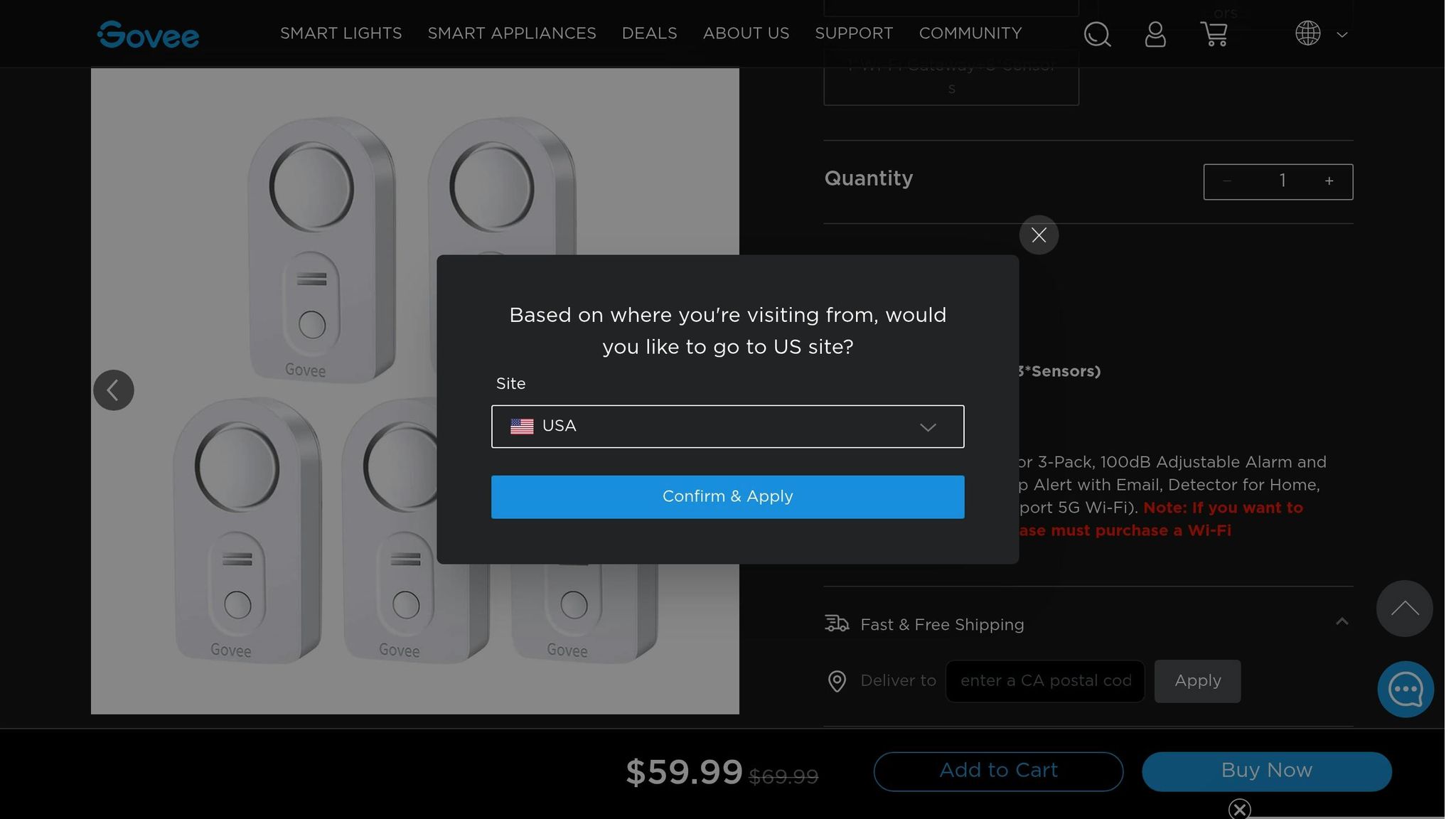
If you’re looking for a dependable and budget-friendly way to monitor your basement for flooding, the Govee Wi-Fi Water Sensors are worth considering. Priced at $43.99, these sensors connect to a Wi-Fi gateway that works seamlessly with the Govee Home App. This setup allows you to keep tabs on your basement – or any other vulnerable area – in real time. When water is detected, the system sends instant alerts to your phone and email, while also triggering a loud 100dB alarm for added awareness.
Equipped with specialized probes, the sensors can detect both dripping and standing water, ensuring early detection of leaks before they escalate into full-blown flooding. With an IP66 waterproof rating, these sensors are well-suited for damp environments like basements.
The Govee Home App makes management easy by letting you label each sensor based on its location. This way, any alerts you receive will specify whether the issue is near your sump pump, water heater, or washing machine. A single gateway can support up to 10 sensors, though you’ll need a 2.4GHz Wi-Fi network and should keep the sensors within 196 feet of the gateway for optimal performance.
With an impressive 4.2/5 rating from over 14,000 Amazon reviews, the Govee Wi-Fi Water Sensors have earned praise for their reliability. However, some users have noted occasional Wi-Fi connectivity issues that can impact alert consistency. While the sensors integrate well with the Govee Home App, they lack direct compatibility with platforms like SmartThings. That said, tech-savvy users have managed to integrate them with systems like Home Assistant through creative workarounds.
At $43.99, the Govee system provides effective and straightforward flood detection. While it may not offer the advanced smart home features of higher-end options, it delivers reliable alerts and essential functionality, making it a great choice for homeowners on a budget.
Next, we’ll explore a premium option that offers deeper smart home integration.
4. Moen Flo Smart Water-Leak Detector
If you’re looking for a way to protect your entire home from water damage, the Moen Flo Smart Water Monitor and Shutoff might be the solution you need. Priced at $458, this system goes beyond basic leak sensors. Instead of just alerting you when a leak happens, it can automatically shut off your water supply to prevent damage as soon as an issue is detected. Using advanced sensors, it can identify even the smallest irregularities in water flow.
The Flo system is installed directly on your main cold water supply line, providing coverage for the entire house. It uses FloSense™ Technology to learn your household’s typical water usage patterns, distinguishing between normal activities and unusual water flow that could indicate a problem[39,40,41]. It also performs Daily MicroLeak™ tests, capable of detecting leaks as small as one drop per minute. Impressively, within the first 30 days of installation, 60% of homeowners discover leaks they were previously unaware of.
When the system detects an issue, it sends real-time alerts through the Moen Smart Water App, as well as via text, email, or even phone calls. Integration with major smart home platforms makes it even more convenient. For example, Ring users can monitor water usage, flow rates, and system pressure directly in the Ring app, while Alarm.com allows you to manage water monitoring alongside other security devices. These integrations ensure you’re always in the loop, no matter where you are.
Professional installation is recommended and typically costs between $500 and $1,000. The device also requires a 2.4 GHz Wi-Fi connection, a nearby AC outlet, and potentially a 25-foot extension cord if needed[39,41,47]. As David Gewirtz, Senior Contributing Editor at ZDNET, shared:
“It cost me about $350 in licensed electrician and plumber hours to get the device installed.”
The Moen Flo system has a solid track record, with a 3.7/5-star rating from over 2,600 reviewers, and 92% of users recommending it[41,42]. However, some customers have mentioned occasional connectivity problems and mixed feedback regarding the battery life of the accompanying leak detectors.
The statistics highlight the importance of such a system: water damage impacts 40% of homes and is six times more common than theft. A single burst pipe causing ceiling damage can cost an average of $12,500 to repair. For homeowners serious about protecting their property and avoiding costly repairs, the Moen Flo system’s automatic shutoff and thorough monitoring capabilities make it a worthwhile investment.
Up next, we’ll explore a smart sensor kit designed for larger homes with expandable coverage.
5. YoLink Smart Water Sensor Kit and Hub
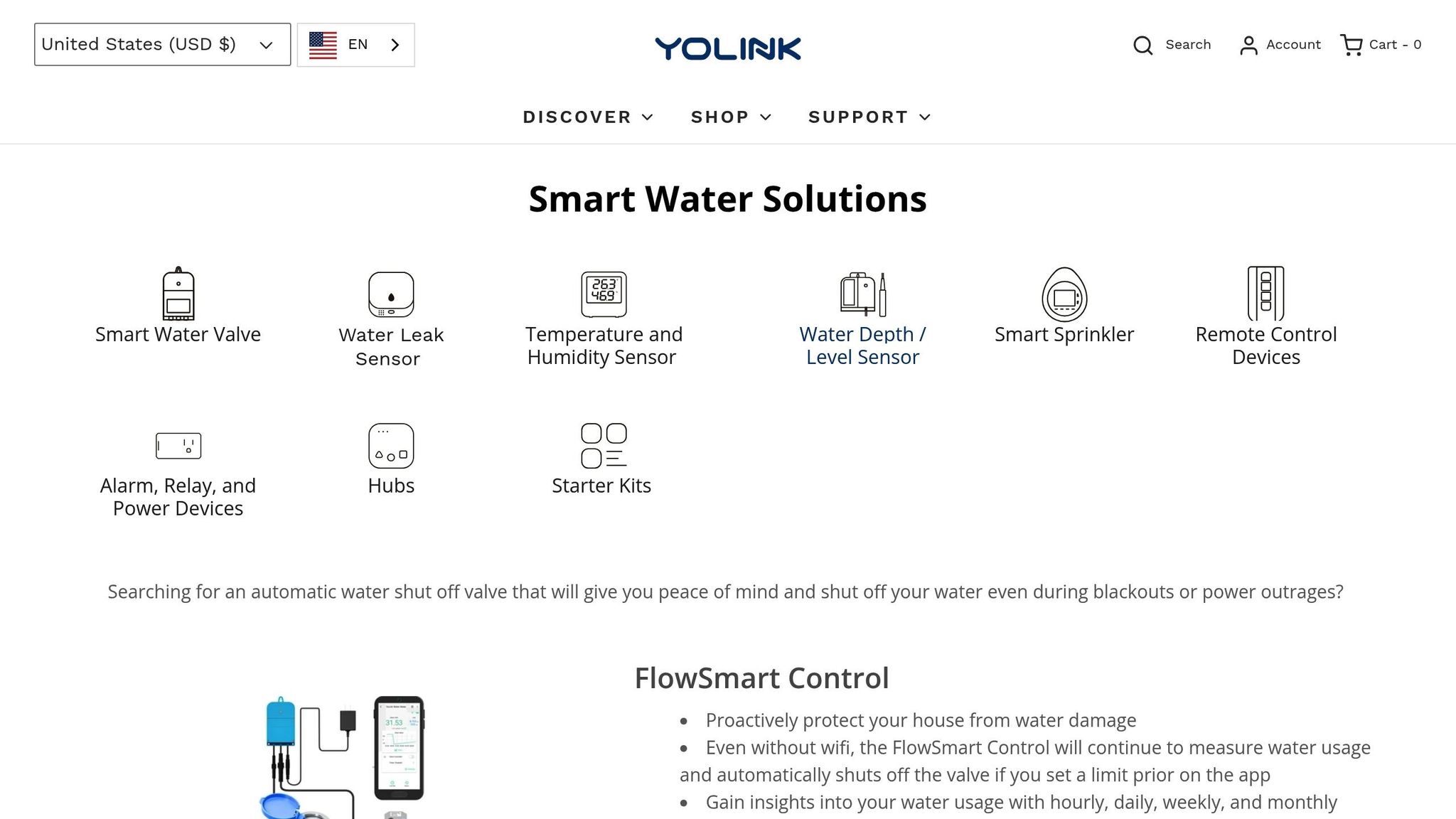
If you’re looking for a reliable water monitoring system with impressive range and flexibility, the YoLink Smart Water Sensor Kit and Hub might be just what you need. Priced at $59.99 for the starter kit, it uses LoRa technology to deliver a communication range of up to 1/4 mile. This makes it perfect for hard-to-reach areas like basements and crawl spaces where Wi-Fi often struggles to perform. For homeowners, this extended range is a game-changer in ensuring comprehensive coverage.
Each Water Leak Sensor 4 is equipped with a loud 105-decibel alarm, so you’ll hear alerts even from far corners of your home. Beyond the audible alarm, the system keeps you informed through SMS, email, and push notifications via the YoLink app, whether you’re at home or on the go.
Setting up YoLink is straightforward, with no subscription fees and a DIY installation process. The hub supports over 300 devices, making it a great fit for larger homes or properties with multiple water sources. Need more sensors? You can add them for just $18 each, allowing you to expand your system without breaking the bank. Plus, it integrates seamlessly with Amazon Alexa, Google Home, IFTTT, and Home Assistant for smart home enthusiasts.
The system’s reliability is backed by its 4.6/5-star rating from over 4,600 Amazon reviews and its status as the #1 Best Seller in Water Detectors & Alarms. One satisfied user shared:
“These are my only smart home devices that out of all, always work. There have never been any issues. No connectivity issues, no update issues, no battery issues. If you use smart home devices, you know how annoying they can be. YoLink just works, all the time. It’s amazing.” – Marsiv
Battery life is another strong point. The sensors can last up to 5 years in standby mode using standard alkaline batteries. However, frequent alerts (such as one every minute) may reduce battery life to about 32 days, though this is rare. The YoLink app also tracks battery levels and alerts you when replacements are needed.
For added peace of mind, YoLink sensors can pair with valve controllers to automatically shut off water when a leak is detected. Thanks to its Control-D2D technology, these sensors can communicate directly with sirens and valves even if the internet is down.
The system’s value extends beyond homes. In May 2025, an insurance company offered up to $100 in reimbursement for homeowners who installed YoLink sensors at every water fixture, highlighting the importance of proactive leak detection. In another instance, a customer in June 2025 reported using YoLink sensors in rental properties to detect leaks under kitchen sinks and in attic spaces, showcasing its versatility.
With its extended range, reliable performance, and easy expandability, YoLink is an excellent choice for anyone looking to protect their home or property from water damage. Whether you’re covering a sprawling house or tackling tricky layouts, YoLink’s robust connectivity and smart features provide dependable water monitoring.
sbb-itb-99db659
6. Eve Water Guard Smart Home Water-Leak Detector
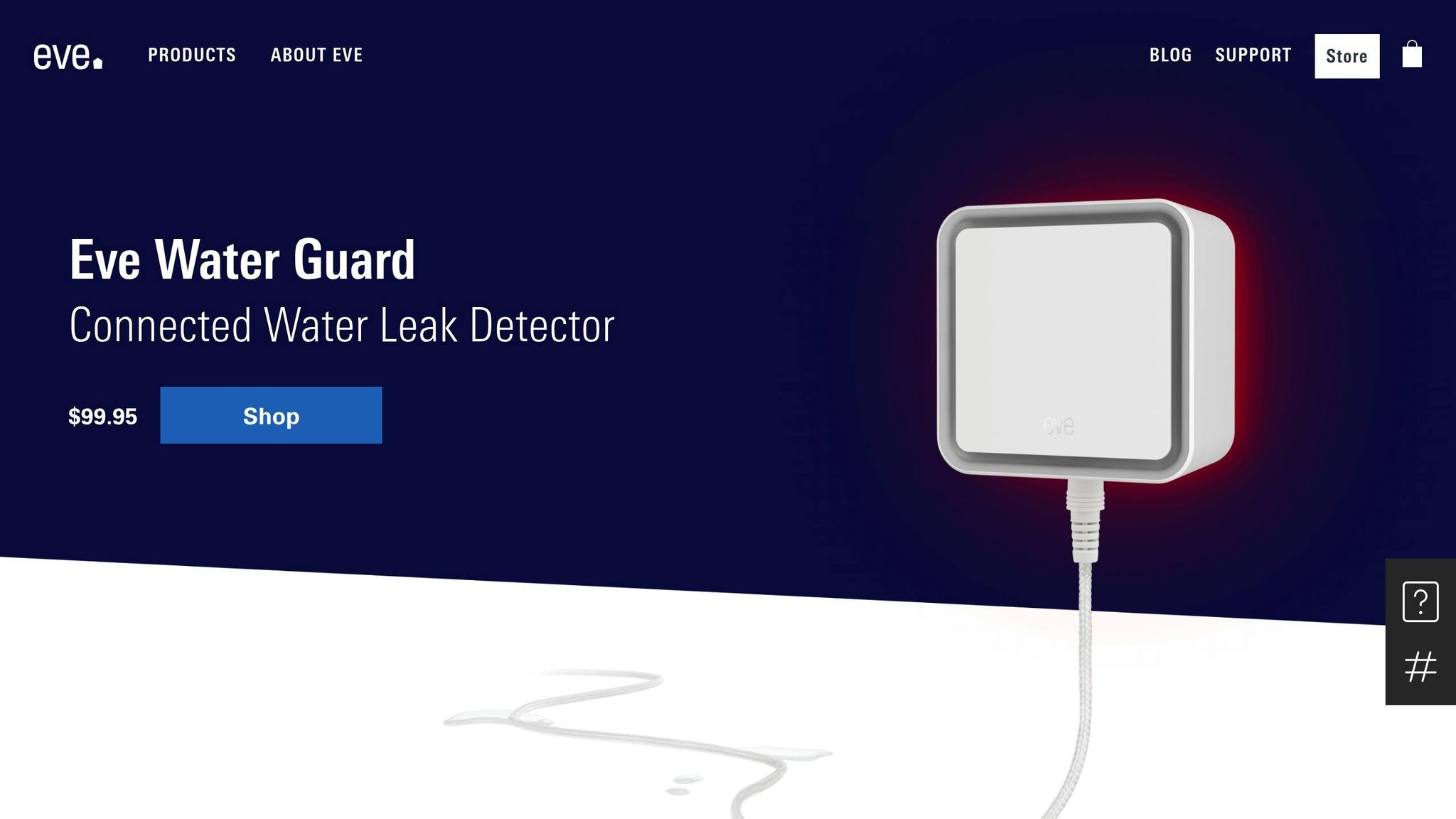
Next up is a water leak detection system designed specifically for those immersed in the Apple ecosystem. The Eve Water Guard, created exclusively for Apple HomeKit, delivers reliable leak detection at a current price of $84.95 (marked down from $99.95).
One of its standout features is the 6.5-foot sensing cable, which acts as a sensor along its entire length, making it ideal for covering larger areas. Need more coverage? You can extend the cable up to an impressive 490 feet (150 meters), perfect for sprawling basements or multiple rooms.
When water is detected, the system springs into action with a 100-decibel siren and sends instant notifications to your iPhone, iPad, or Apple Watch. It connects seamlessly to Apple devices via Bluetooth and Thread technology, eliminating the need for a hub while enhancing network reach. Plus, its Thread support ensures it’s ready for future Matter compatibility.
One of its key advantages is data security – it keeps everything within the Apple ecosystem. Installation is straightforward for HomeKit users, and the device boasts a solid 4.6-star rating from 171 Amazon reviews.
The Eve Water Guard runs on mains electricity, so you won’t have to worry about replacing batteries. It also includes interchangeable plug adapters for different regions and features a built-in test function accessible through the Eve app.
For remote access and notifications while you’re away, you’ll need an Apple TV (4th generation or later) or a HomePod as a home hub. Full functionality requires an iPhone or iPad running the latest iOS or iPadOS.
Although it’s priced on the higher side, its seamless HomeKit integration and reliability make it a worthwhile investment. As Wired put it:
“If you already have a HomeKit setup, this is a solid pick”.
Considering that about 1 in 50 insured homes experiences water damage or freezing each year, the Eve Water Guard can be a valuable addition to your home’s flood protection system, especially for safeguarding your basement.
7. Fibaro Flood, Water, and Temperature Sensor
Finishing off our list is the Fibaro Flood, Water, and Temperature Sensor, a compact yet powerful device that goes beyond just spotting water leaks. At just 2.8 inches in diameter and 1.1 inches in height, this small sensor packs a punch with its multi-functionality and thoughtful design.
What makes the Fibaro sensor stand out is its ability to handle three key tasks: detecting water leaks, monitoring temperature with an impressive accuracy of 0.9°F (0.5°C), and offering tamper protection. It operates within a wide temperature range, from –4°F to 212°F, making it ideal for keeping an eye on both flooding risks and temperature changes in areas like basements.
The device runs on a CR123A battery, which lasts around two years, or it can be powered by a 12–24V DC supply with a battery backup. If water is detected, the sensor springs into action with a sound alarm, a flashing LED indicator, and Z-Wave notifications sent straight to your smartphone.
One of its clever features is its floating design, which ensures it keeps sending alerts even if submerged during significant flooding. Its wireless range reaches up to 164 feet outdoors and between 98–131 feet indoors, depending on the building’s layout.
The Fibaro sensor also integrates smoothly with smart home systems. It comes in two versions: a Z-Wave model that works with various smart home platforms and Android/iOS devices, and an Apple HomeKit version that uses Bluetooth and is designed exclusively for Apple devices running iOS 9.3 or later. The HomeKit version even has the ability to trigger compatible smart bulbs to change color when water is detected, adding an extra layer of visual alert.
For added convenience, you can install the sensor on the floor or mount it on a wall. It also allows you to extend its flood sensor probe with a wire for those hard-to-reach spots. Plus, the built-in tilt sensor acts as a theft deterrent by notifying the main controller if the device is moved.
While some users have reported occasional connectivity hiccups, most agree that its reliable water detection, temperature monitoring, and seamless smart home integration make it an effective tool for safeguarding your basement.
Product Comparison Chart
Choosing the right basement flood alarm can be overwhelming, but comparing key features side-by-side makes it easier to find the best fit for your needs. Below is a detailed comparison chart to help you quickly evaluate different options.
| Product | Price Range | Alert Methods | Smart Home Compatibility | Key Features | Battery Life |
|---|---|---|---|---|---|
| Kangaroo Water + Climate Sensor | $29.99 | App notifications, email | Limited smart home integration | Water detection + climate monitoring | 1–2 years (CR2 batteries) |
| LeakSmart Water Leak Detection System | $200–$500+ | App alerts, automatic shutoff | Works with major platforms | Automatic water shutoff, professional monitoring | 2–3 years (varies by component) |
| Govee Wi‑Fi Water Sensors | $40–$50 (3‑pack) | 80 dB local alarm, push notifications | Amazon Alexa | Wi‑Fi connectivity, multiple sensors | 1–2 years (AAA batteries) |
| Moen Flo Smart Water‑Leak Detector | $40–$60 per sensor | App notifications, email | No smart assistant integration | Compact design, instant alerts | 2 years (CR123A battery) |
| YoLink Smart Water Sensor Kit and Hub | Around $300 | App, SMS, email alerts | Amazon Alexa, IFTTT | LoRa technology, extended range | 2+ years (CR2450 battery) |
| Eve Water Guard Smart Home Water‑Leak Detector | $80–$100 | Red light, loud alarm, HomeKit alerts | Apple HomeKit only | Cable sensor design, extension probe | 2 years (CR123A battery) |
| Fibaro Flood, Water, and Temperature Sensor | $80–$120 | Sound alarm, LED, Z‑Wave notifications | Z‑Wave platforms, Apple HomeKit | Multi‑sensor functionality, floating design | 2 years (CR123A or DC power) |
The chart highlights a range of options, from budget-friendly choices ($30–$60) to high-end systems exceeding $200. Alert methods vary widely, offering everything from local alarms to app notifications and even automatic water shutoff. Smart home compatibility also differs, with some models integrating with platforms like Amazon Alexa, Apple HomeKit, or Z-Wave systems. Most devices feature battery lives of around two years, ensuring consistent reliability.
For example, a property owner in Ontario, CA, installed the Govee Wi‑Fi Water Sensors after experiencing a $5,000 washing machine leak. The sensors successfully alerted them to another potential issue, allowing them to shut off the water and avoid further damage. This real-life scenario underscores how even premium flood alarm systems can be a valuable investment in protecting your home and basement.
Final Thoughts
Setting up a basement flood alarm system is a smart move that can save you a lot of money in the long run. These systems provide timely alerts, helping you avoid thousands of dollars in water damage costs.
To get the most out of your investment, choose a system tailored to your home’s layout and specific needs. Start by identifying areas in your basement that are most vulnerable to leaks or flooding. Think about the condition of your plumbing and appliances, especially if they’re older, as they are more likely to fail or leak. Matching your system’s monitoring capabilities to these factors ensures better protection.
Consider features that fit your lifestyle. For example, active alarms that detect water flow changes and can shut off the water supply are ideal for those who travel frequently or spend long hours away from home. On the other hand, wireless sensors offer easier installation and more flexibility in placement, while wired sensors tend to provide more stable and reliable performance.
Proper sensor placement is key to maximizing the system’s effectiveness. Place sensors near high-risk areas like water heaters, sump pumps, washing machines, or floor drains. Systems with smartphone alerts, smart home integration, or automatic shut-off options add an extra layer of protection, especially when you’re not at home.
The financial advantages go beyond preventing damage. Water damage is the second most common type of homeowners insurance claim, with average repair costs hovering around $10,900. Many insurance companies now offer discounts – up to 8% – on premiums for homes equipped with comprehensive water detection systems. Additionally, early leak detection can prevent the waste of up to 10,000 gallons of water per year, which is the average for undetected leaks in households.
Ultimately, choose a system that fits your budget and meets your specific needs. The protection these devices offer far outweighs their cost. By taking this proactive step, you’re not just safeguarding your basement but also your finances, ensuring peace of mind and long-term savings.
FAQs
How can I choose the best basement flood alarm for my needs and budget?
Choosing the right basement flood alarm comes down to understanding your needs and budget. Start by pinpointing the areas in your basement most vulnerable to water damage – common spots include around sump pumps, water heaters, or washing machines. Once you’ve identified these risk zones, think about how many sensors you’ll need. For most homes, four sensors are enough to cover the main areas of concern.
Flood alarms can cost anywhere from $150 to $1,200, with the average falling around $400. Decide on a budget and look for alarms that meet your requirements. Features like audible alerts, mobile notifications, or visual signals can make a big difference in how quickly you respond to potential flooding. Also, consider how easy the system is to install – many alarms are designed for quick, DIY setup. By keeping these factors in mind, you can choose a dependable alarm system that safeguards your home without breaking the bank.
What are the benefits of connecting a flood alarm to your smart home system?
Integrating a flood alarm into your smart home system brings a host of benefits, starting with real-time alerts. These alerts let you know immediately about water leaks or flooding, so you can act quickly to prevent costly damage or the development of mold. Even if you’re away from home, your smartphone will notify you instantly, keeping you in the loop no matter where you are.
Beyond just alerts, a smart flood alarm adds an extra layer of safety to your home. It can also increase your property’s value and offers remote monitoring and control, making it easier to stay ahead of potential flooding issues. Whether you’re a homeowner or a business owner, this kind of proactive protection offers peace of mind, helping safeguard your space from unexpected water damage.
What are the best tips for maintaining and installing basement flood alarms to ensure they work effectively?
Tips for Keeping Your Basement Flood Alarm in Top Shape
To ensure your basement flood alarm is always ready to protect your home, start by placing the sensors in areas most prone to water issues. These include spots near sump pumps, water heaters, or along basement walls where leaks are more likely to occur.
Make it a habit to test the alarm system regularly to confirm it’s working as it should. Don’t forget to replace the batteries when needed to prevent any lapses in functionality. For added peace of mind, consider installing a battery backup. This ensures your flood alarm stays active even during power outages.
When setting up the system, seal any potential water entry points with silicone caulk. This step not only reduces the chances of water seeping in but also helps prevent unnecessary false alarms. With proper sensor placement and periodic maintenance, your flood alarm will be ready to respond when you need it most.

